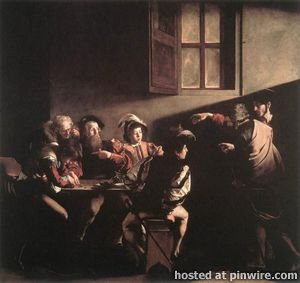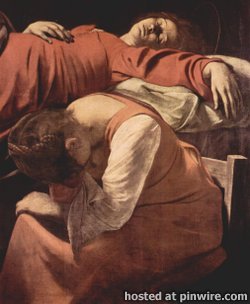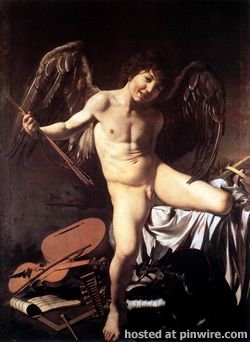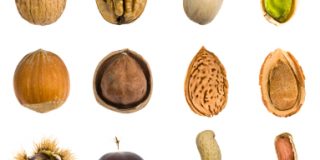‘Most famous painter in Rome’ (1600-1606)
 The Calling of Saint Matthew. 1599-1600. Oil on canvas, 322 x 340 cm. Contarelli Chapel, San Luigi dei Francesi, Rome. The beam of light, which enters the picture from the direction of a real window, expresses in the blink of an eye the conversion of St Matthew, the hinge on which his destiny will turn, with no flying angels, parting clouds or other artifacts |
In 1599, presumably through the influence of Del Monte, Caravaggio contracted to decorate the Contarelli Chapel in the church of San Luigi dei Francesi. The two works making up the commission, the Martyrdom of Saint Matthew and Calling of Saint Matthew, delivered in 1600, were an immediate sensation. Caravaggio’s heightened chiaroscuro brought high drama to his subjects, while his acutely observed realism brought a new level of emotional intensity.
This heightened form of chiaroscuro is known as tenebrism, and he is credited with popularizing it. Opinion among Caravaggio’s artist peers was polarized.
Some denounced him for various perceived failings, notably his insistence on painting from life, without drawings, but for the most part he was hailed as the saviour of art: “The painters then in Rome were greatly taken by this novelty, and the young ones particularly gathered around him, praised him as the unique imitator of nature, and looked on his work as miracles.”[11]
 Death of the Virgin (detail). 1601 – 1606. Oil on canvas, 396 x 245 cm. Louvre, Paris. |
Caravaggio went on to secure a string of prestigious commissions for religious works featuring violent struggles, grotesque decapitations, torture and death. For the most part each new painting increased his fame, but a few were rejected by the various bodies for whom they were intended, at least in their original forms, and had to be re-painted or find new buyers.
The essence of the problem was that while Caravaggio’s dramatic intensity was appreciated, his realism was seen by some as unacceptably vulgar.[12] His first version of Saint Matthew and the Angel, featured the saint as a bald peasant with dirty legs attended by a lightly-clad over-familiar boy-angel, was rejected and had to be repainted as The Inspiration of Saint Matthew.
Similarly, The Conversion of Saint Paul was rejected, and while another version of the same subject, the Conversion of Saint Paul, was accepted, it featured the saint’s horse’s haunches far more prominently than the saint himself, prompting this exchange between the artist and an exasperated official of Santa Maria del Popolo: “Why have you put a horse in the middle, and Saint Paul on the ground?” “Because!” “Is the horse God?” “No, but he stands in God’s light!”[13]
 Amor Vincit Omnia. 1602 – 1603. Oil on canvas. 156 x 113 cm. Gemäldegalerie, Berlin. Caravaggio shows Cupid prevailing over all human endeavors: war, music, science, government. |
Other works included the deeply moving Entombment, the Madonna di Loreto (Madonna of the Pilgrims), the Grooms’ Madonna, and the Death of the Virgin. The history of these last two paintings illustrate the reception given to some of Caravaggio’s art, and the times in which he lived. The Grooms’ Madonna, also known as Madonna dei palafrenieri, painted for a small altar in st.Peter’s Basilica in Rome, remained there for just two days, and was then taken off.
A cardinal’s secretary wrote: ” In this painting there are but vulgarity, sacrilege, impiousness and disgust…One would say it is a work made by a painter that can paint well, but of a dark spirit, and who has been for a lot of time far from God, from His adoration, and from any good thought…”.[citation needed] The Death of the Virgin, then, commissioned in 1601 by a wealthy jurist for his private chapel in the new Carmelite church of Santa Maria della Scala, was rejected by the Carmelites in 1606. Caravaggio’s contemporary Giulio Mancini records that it was rejected because Caravaggio had used a well-known prostitute as his model for the Virgin;[14] Giovanni Baglione, another contemporary, tells us it was because of Mary’s bare legs:[15] a matter of decorum in either case.
But Caravaggio scholar John Gash suggests that the problem for the Carmelites may have been theological rather than aesthetic, in that Caravaggio’s version fails to assert the doctrine of the Assumption of Mary, the idea that the Mother of God did not die in any ordinary sense but was assumed into Heaven. The replacement altarpiece commissioned (from one of Caravaggio’s most able followers, Carlo Saraceni), showed the Virgin not dead, as Caravaggio had painted her, but seated and dying; and even this was rejected, and replaced with a work which showed the Virgin not dying, but ascending into Heaven with choirs of angels. In any case, the rejection did not mean that Caravaggio or his paintings were out of favour. The Death of the Virgin was no sooner taken out of the church than it was purchased by the Duke of Mantua, on the advice of Rubens, and later acquired by Charles I of England before entering the French royal collection in 1671.
One secular piece from these years is Amor Victorious, painted in 1602 for Vincenzo Giustiniani, a member of Del Monte’s circle. The model was named in a memoir of the early 17th century as “Cecco”, the diminutive for Francesco. He is possibly Francesco Boneri, identified with an artist active in the period 1610-1625 and known as Cecco del Caravaggio (‘Caravaggio’s Cecco’),[16] carrying a bow and arrows and trampling symbols of the warlike and peaceful arts and sciences underfoot. He is unclothed, and it is difficult to accept this grinning urchin as the Roman god Cupid – as difficult as it was to accept Caravaggio’s other semi-clad adolescents as the various angels he painted in his canvases, wearing much the same stage-prop wings. The point, however, is the intense yet ambiguous reality of the work: it is simultaneously Cupid and Cecco, as Caravaggio’s Virgins were simultaneously the Mother of Christ and the Roman courtesans who modeled for them.



